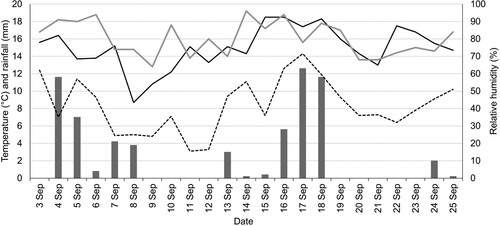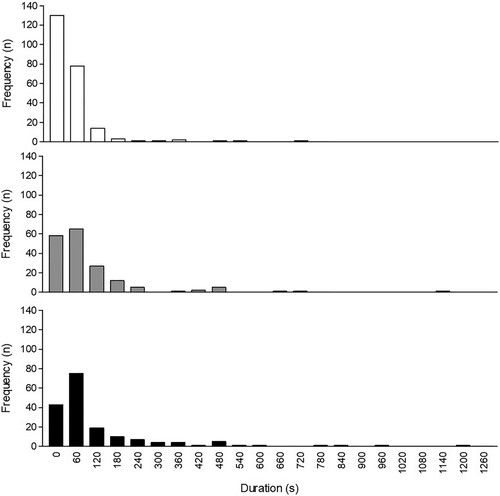Figures & data
Table 1. Ethogram of ewe suckling behaviour and type of measure observed from video footage.
Figure 1. Summary of weather data showing daily minimum temperature (°C, dashed black line), maximum temperature (°C, solid black line) and mean relative humidity (%, solid grey line) and total rainfall (mm, black bars) recorded during the study period.

Table 2. The number of suckling events, events with rain recorded and events with a chill index of greater than 1000 KJ/m2 for each wind direction (north, east, south and west). Median and interquartile range in parentheses of wind speed (m/s), temperature (°C), rain rate (mm/h), relative humidity (%), solar radiation (MJ/m2) and chill index (MJ/m2) when wind was from each direction.
Figure 2. Histogram of suckling event duration on day 1 when one (white bars), two (grey bars) or three (black bars) lambs were present at the termination of the event.

Table 3. The frequency of suckling events (with the percentage in parentheses) and their duration (s, back-transformed mean with 95% confidence interval in parentheses) on Day 1 by number of lambs present at the end of the event (one, two or three) and on Days 1, 2 and 3 by lambs present at the end of the event or by day of observation.
Table 4. The frequency of suckling events (with the percentage in parentheses) and their duration (s, back-transformed mean with 95% confidence interval in parentheses) on day 1 only and on days 1, 2 and 3 by wind direction.
Table 5. The frequency and percentage (in parentheses) of suckling events that were terminated by the ewe (kick, sit, butt and walk) or lambs (walk) on Day 1 by number of lambs present (one, two or three) and Days 1, 2 and 3 by lambs present or by day of observation (Day 1, Day 2 or Day 3).
Table 6. The odds (with 95% confidence interval in parentheses) of suckling events being terminated by the ewe walking away or by the lamb on Day 1 by number of lambs present (one, two or three) and on Days 1, 2 and 3 by the number of lambs present or by day of observation.
Table 7. The frequency (with the percentage in parentheses) of suckling events during which ewes were observed to walk, stand, ruminate or graze on Day 1 by number of lambs present (one, two or three) and on Days 1, 2 and 3 by lambs present (one, two or three), day of observation or total days of observation (one or three).
Table 8. The frequency (with the percentage in parentheses) of suckling events during which ewes were observed to walk, stand, ruminate or graze on Day 1 and Days 1, 2 and 3 by wind direction during the event.
Table 9. The median percentage (with interquartile range in parentheses) of the total suckling event duration that ewes were observed to walk, stand, ruminate or graze by the number lambs present at the end of the event or day of observation.
Table 10. The median percentage (with interquartile range in parentheses) of the sum of the suckling events that ewes were observed to walk, stand, ruminate or graze by the number of lambs present or the day of observation.
Table 11. The odds (with 95% confidence interval in parentheses) of a ewe being observed to walk, stand, ruminate or graze at any time during all periods they were observed to suckle their lambs by number by the number of lambs present or day of observation.
